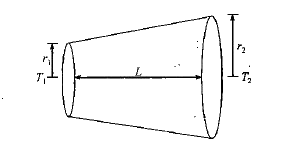The temperature drop through each layer of a two layer furnace wall is shown in Assume that the external temperature T10 and T3 are mainitained constant and T1>T3 If the thichness of the layers x1 and x2 are the same which of the following statements are correct
 .
.
k1>k2
k1<k2
k1=k2 but heat flow through material (1) is less then through (2) .
k1=k2 but heat flow through material (1) is less then through (2) .
The correct Answer is:A
dQdt=KAdθdx0
dθdx= slope of graph α1K .
Topper's Solved these Questions
- TRANSMISSION OF HEATBOOK - NARAYNACHAPTER - TRANSMISSION OF HEATEXERCISE - NCERT BASED QUESTIONS
5 Videos
- TRANSMISSION OF HEATBOOK - NARAYNACHAPTER - TRANSMISSION OF HEATEXERCISE - SINGLE ANSWER QUESTIONS Passage
1 Videos
- TRANSMISSION OF HEATBOOK - NARAYNACHAPTER - TRANSMISSION OF HEATEXERCISE - LEVEL-III (C.W)
1 Videos
- THERMODYNAMICSBOOK - NARAYNACHAPTER - THERMODYNAMICSEXERCISE - Exercise
187 Videos
- UNITS AND MEASUREMENTSBOOK - NARAYNACHAPTER - UNITS AND MEASUREMENTSEXERCISE - STATEMENT TYPE QUESTION
23 Videos
Similar Questions
Knowledge Check
If K1= Rate constant at temperature T1 and k2 rate constant at temperature T2 for a first order reaction, then which of the following relation is correct ?
Alog.k2k1=2.303RT[T2−T1T1T2]Blog.k2k1=Ea2.303RT[T2−T1T1T2]Clog.k2k1=Ea2.303RT[T1T2T2−T1]Dlog.k1k2=Ea2.303RT[T2T2T2−T1]Curved surface of a uniform rod is isolated from surrounding. Ends of the rod are maintained at temperatures T1 and T2(T1>T2) for a long time. At an instant, temperature T1 starts to decrease at a constant and slow rate. If thermal capacity of material of the rod is considered, then which of thefollowing statements is/are correct ?
A) At an instant,rate of heat flow near the hotter end is equal to that near the other endBRate of heat flow through the rod starts to decrease near the hotter end and remains constant near the other endCRate of heat flow is maximum at mid section of the rodDNone of these
The temperature drop through a two layer furnace wall is 900∘C. Each layer is of equal area of cross section. Which of the following actions will result in lowering the temperature θ of the interface?ABy increasing the thermal conductivity of outer layerBBy increasing the thermal conductivity of inner layerCBy increasing thickness of outer layerDBy increasing thickness of inner layer
Find the heat current through the frustum of a cone shown in figure-4.20. Temperature of its two ends are maintained at T1 and T2(T_(2)>T_(1)) respectively and the thermal conductivity of the material is k.

View SolutionThe temperature drop through a two layer furnace wall is 600∘C. Each layer is of equal area of cross section. Which of the following actions will result in lowering the temperature θ of the interface ?

View SolutionShow below are the black body radiation curves at temperature T1 and T2(T2>T1). Which of the following plots is correct?
View SolutionShown below are the black body radiation curves at temperature T1 and T2(T2>T1). Which of the following plots is correct?
View SolutionFor the following graph, drawn from two different samples of gases at two different temperatures T1andT2, which of the following statements is/are necessarily true?

View Solution
